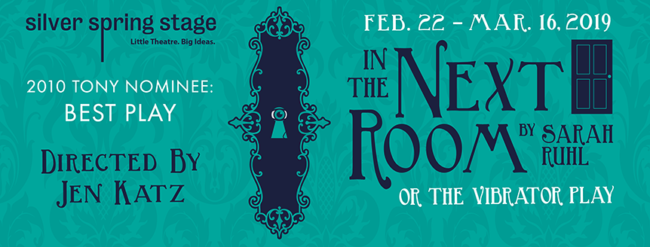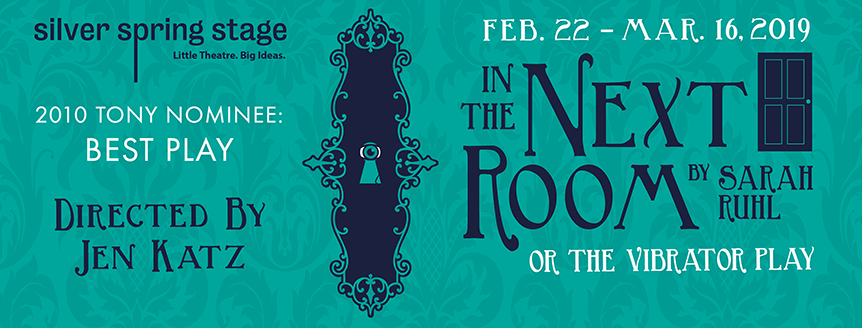What thing can put a man to death and bring him back to life again? Why the cure for women’s hysteria, naturally, or better known as electricity. Thank you, Mr. Edison, for the focal point of Sarah Ruhl’s play with two titles, In The Next Room or The Vibrator Play. While electricity does run as a strong alternating and direct current throughout the script, there are so many more deeply layered, multi-faceted components of this play that make it an exquisite exploration of human relationships. In The Next Room or The Vibrator Play is currently electrifying Silver Spring Stage under the direction of Jen Katz and has a raw, pulsating heartbeat of curiosity and intrigue as well as passion and love coursing through it from start to finish.

Scenic Designer Jeff Asjes takes a visionary approach to conquering the daunting task of an integral scenic component of this play for Silver Spring Stage’s unique playing space. Because of the L-shaped audience divide (structured because of the load-bearing support pillar at the forward apex of the stage) set designers and directors alike have had to embrace innovative and unconventional practices with scenery and blocking to make a show truly successful at Silver Spring Stage. Sarah Ruhl’s play has a space divided— the front room of the Givings’ home and the operating theatre. Most proscenium stages align them side by side with a physical barrier wall between them, but do to the unique configuration of the audience, if Asjes were to split the stage at its diagonal middle, half of the production would be precluded from half of the house, depending upon where you were sitting during certain scenes. But the wall is a crucial barrier in Ruhl’s work; it serves not only as a physical barrier to separate the spaces but also as a symbolic one, drawing the juxtaposition between Doctor Givings’ home life and his scientific work life, and the subsequent isolation that Mrs. Givings feels from that division. Asjes creates a wall, or rather an illusion of one, that splits the set into perfect compartments without obstructing anyone’s view.
But part of Asjes’ success with this illusory wall is the work of Lighting Designer Steve Deming. Bringing the lights of the operating theatre and the front room of the Givings’ home up and down with impeccable cues to show movements in and out of the respective rooms, is a job well-accomplished by Deming. He also uses subtle dimming of the full overhead lights (and subtle brightening when the condition is reversed) whenever the new ‘electric lamp’ (represented by a strategically placed ghost light) is switched off and on, respectively. Deming uses a blue hue to augment the show’s finale, which takes place outside the Givings’ home on the grounds in Mrs. Givings’ winter garden, at night, in December. This subtle and charismatic hue is just the right touch for the show’s rather endearing ending.
The dawn of the age of electricity— or post-Civil-War-circa-1880’s— is no easy feat for costuming, and while there are minor details that feel ever so slightly out of place, on the whole, Costume Designer Mary Wakefield fits the characters into that era in a believable fashion. This is particularly important for the women in the piece— at the very least for Mrs. Givings and Sabrina Daldry as we see both of these women undress down to their underthings and the de-layering process is indeed a laborious task. The casual dresses for these women speak of their station but are not too grandiose. (Even Elizabeth— the hired housekeeper turned wet-nurse— has a fancier dress, which feels slightly out of place for her character’s station but one could suppose that perhaps her employer has either gifted it to her or insisted upon it for when she travels out of their home.) Ultimately the costumes work, and the snafus— both in detail and in function (primarily the reassembly of them to their respective women)— are forgivable.
Two team members of the production team that deserve recognition to this performance specifically are Properties Designer Jennifer Dorsey and Intimacy Coach Christine Hurst. Dorsey’s fabrication of both “the device” and the “Chattanooga” version of the device are quite impressive; they keep with the times but still readily showcase their function. Hurst, whose coaching in this production is invaluable to the believability of the performances, has crafted extremely intimate moments between Doctor Givings and Annie with their patients, though not in the traditional sense that one might expect them. Without plunging the depths of the play’s nature or subject matter, Hurst’s coaching is an intrinsic part of its natural success.
Director Jen Katz pulls together an impressive cast for this production. There are times where the pacing feels the slightest bit slack, though these moments are few and far between and often noticeable because of the lack of complex and intricate soundscape. Katz’ casting decisions make for an intriguing experience as characters are expressed in fashions outside of the more traditional way of approaching this play and on the whole this works for the show. At certain points throughout the show’s progress, however, modernity creeps its way into the action, disrupting the fantasy of time and place in an unintentional fashion. This occurs mostly with Mrs. Givings (Emily H. Gilson) whose cadence and delivery of lines— particularly in moments of heated anger and temper— is present day 21st century, rather than late 19th century. The difference puts her slightly out of step with the others, in particular her husband.
Despite Gilson’s modernity, her portrayal of Catherine Givings is of great interest. When she is calmer and more subdued in scenes, there is a desperate curiosity present in her mannerisms; her physique even shifts to show a more timid yet eager type of character. This is experienced early on in the production and again in the final scene, when everything has come undone. Gilson has a fine scene with Dick Daldry (Jim Adams) early on in the production, whilst debating what sort of people they really are— all revolving around an umbrella; she transcends the text with grace to point out its deeper meaning and readily unearths the umbrella analogy in her own charming way.
The character of Elizabeth (Jacqueline Youm), despite existing only briefly, delivers the most emotionally loaded moment of the play, later in the second act when she makes her speech about her position as a wet-nurse. The raw, undulating power of visceral emotions drives that speech from beginning to end, making it the most evocative passage in the show. Annie (Erica Smith) who has no direct course of interaction with the Elizabeth character, has equally magnetic moments in her character’s path, however, most of these are silent. Smith’s character does very little talking, though when she does it is a curious blend of clinical detachment and endearing comfort. Her body language says a great deal more, however, particularly when she’s left alone in the operating theatre. Despite the dimness of the lighting in that moment (intentional due to the scene shift), watch Smith’s body closely as well as her face, and an entire story plays out in mere seconds through a series of shifts with body language and facial expressions.
While the play has an element of calmness to it, there is always a burbling undercurrent of tension, sparked to life and driven forward by electricity— be it actual or metaphorical— and that is experienced best with Leo Irving (Joshuah Liard.) Arguably one of the more eccentric characters, he is after all a painter, Liard’s portrayal of Irving makes for both comic relief and emotional grounding depending upon which character he is interacting with and in what scene.
Sabrina Daldry (Juliet Lloyd), wife of the aforementioned Dick Daldry, is a most excitable creature. Prone to nerves and fits of hysterics, she’s brought to Doctor Givings to receive ‘the treatment.’ When Lloyd is placed upon the operating theatre’s table, the performance she gives there is delightfully simplistic and tenderly understated. There is no melodramatic heightening of that moment or campiness to it, but rather a subtle rawness that makes her orgasm at the hands of “the device” seem quite believable. (A secondary nod to intimacy coach Christine Hurst is deserved here.) Lloyd plays the sitting room piano in real time and there is something remarkable about the way she channels the character’s energy into the tunes. Versatile in a mild and refined way, Lloyd keeps the character of Sabrina Daldry from becoming a screaming ninny of a side-supporting role.
Strangely aloof and oddly detached, Dr. Givings (Mat J. Bannister) is truly a marvel in this performance. While the text and interactions with other characters almost seems to cry out for a calloused, infuriated, quarrelsome man of science, Director Jen Katz and Matt J. Bannister have wisely chosen to portray him in a different light. The clinical detachment of science is at the forefront of Bannister’s character, however, it is presented in a kindly befuddled nature. Science is what the Doctor understands, emotions are a foreign tongue to him; this clinical detachment leaves Dr. Givings emotionally vacant but not in an empty fashion. These choices drive the scenes of infernal emotional entanglement with such a fascinating new approach that it practically reinvents Ruhl’s work. When the tension finally breaks in Dr. Givings, and emotions of the more infuriated variety, are forced to the surface, it is that much more intense because of this quaint and almost endearing aloofness and sterile detachment Bannister has created from his own emotions. There is a rather sweet human being, shrouded in the clouds of electricity and science, sparking just beneath the surface of Dr. Givings, and the finale scene becomes so much more profound because of Bannister’s approach to the character. His facial expressions in responses to things that might initially make the character angry or jealous are priceless because they possess deep perplexity, confusion, and hints of curiosity. Bannister has reinvented Dr. Givings and re-humanized both the character and his half of the play in doing so.
There are a great many pleasurable things about Silver Spring Stage’s production of In The Next Room or The Vibrator Play; it is lively and burbling with electrical currents of all sorts. Don’t miss out on this thrilling stage engagement, playing through mid-March!
Running Time: 2 hours and 25 minutes with one intermission
In The Next Room or The Vibrator Play runs through March 16, 2019 at Silver Spring Stage, located in the Woodmoor Shopping Center— 10145 Colesville Road in Silver Spring, MD. For tickets call the box office at 301-593-6036 or purchase them online.

